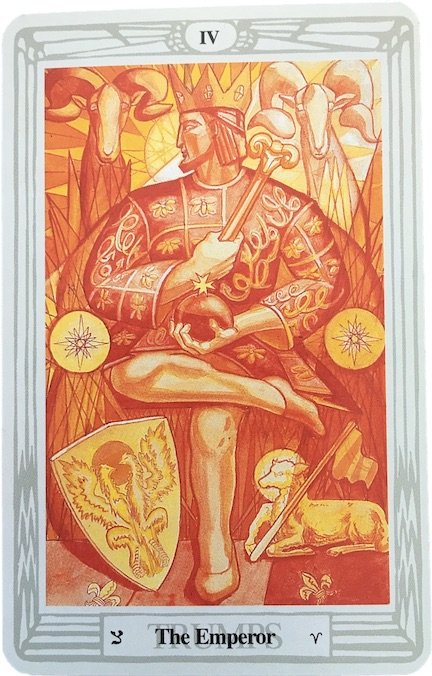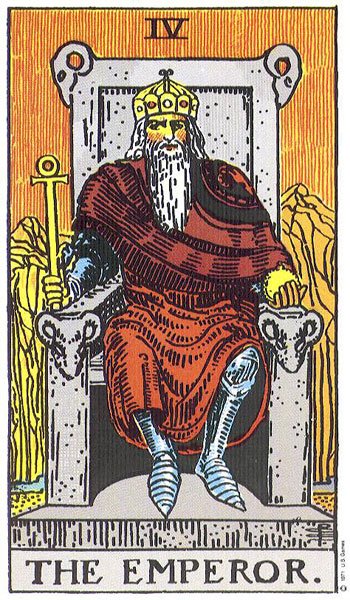THE EMPEROR : KEY IV
chief among the Mighty
Zodiacal Trump of Aries
Mars Rules
Sol Exalted
Alchemical Sulfer
Hebrew Letter: He’ (Window)
Path 15 joining
Sphere 2-Wisdom and 6-Beauty
Use all thine energy to rule thy thought: burn up thy thought as the Phoenix.
War, conquest, victory, strife, ambition, originality, overweening confidence and megalomania, quarrelsomeness, energy, vigour, stubbornness, impracticability, rashness, ill-temper.
Alesiter Crowley
The Book of Thoth
This card is attributed to the letter Tzaddi (He’), and it refers to the sign of Aries in the Zodiac. This sign is ruled by Mars, and therein the Sun is exalted. The sign is thus a combination of energy in its most material form with the idea of authority. The sign TZ or TS implies this in the original, onomatopoetic form of language. It is derived from Sanskrit roots meaning Head and Age, and is found to-day in words like Caesar, Tsar, Sirdar, Senate, Senior, Signor, Señor, Seigneur.
Sire and inceptor, Emperor and King Of all things mortal, hail Him lord of Spring!
The card represents a crowned male figure, with imperial vestments and regalia. He is seated upon the throne whose capitals are the heads of Himalayan wild ram, since Aries means a Ram. At his feet, couchant, is the Lamb and Flag, to confirm this attribution on the lower plane; for the ram, by nature, is a wild and courageous animal, lonely in lonely places, whereas when tamed handmade to lie down in green pastures, nothing is left but the docile, cowardly, gregarious and succulent beast. This is the theory of government.
The Emperor is also one of the more important alchemical cards; with Atu II and III, he makes up the triad: Sulphur, Mercury, Salt. His arms and head form an upright triangle; below, crossed legs represent the Cross. This figure is the alchemical symbol of Sulphur (see Atu X). Sulphur is the male fiery energy of the Universe, the Rajas of Hindu philosophy. This is the swift creative energy, the initiative of all Being. The power of the Emperor is a generalization of the paternal power; hence such symbols as the Bee and the Flour-de-lys, which are shown on this card. With regard to the quality of this power, it must be noted that it represents sudden, violent, but impermanent activity. If it persists too long, it burns and destroys. Distinguish from the Creative Energy of Aleph and Beth: this card is below the Abyss.
The Emperor bears a scepter (surmounted by a ram’s head for the reasons given above) and an orb surmounted by a Maltese cross, which signifies that his energy has reached a successful issue, that his government has been established.
There is one further symbol of importance. His shield represents the two-headed eagle crowned with a crimson disk. This represents the red tincture of the alchemist, of the nature of gold, as the white eagle show in Atu III pertains to his consort, the Empress, and is lunar, of silver.




Joan Bunning
The figure of the Emperor says much about the essential qualities of this card. We see a stern, commanding figure seated on a stone-slab throne. His back is straight, and his eyes meet ours directly. He is confident of his complete authority to rule.
The Emperor represents structure, order and regulation – forces to balance the free-flowing, lavish abundance of the Empress. He advocates a four-square world where trains are on time, games are played by rules, and commanding officers are respected. In chaotic situations, the Emperor can indicate the need for organization. Loose ends should be tied up, and wayward elements, harnessed. In situations that are already over-controlled, he suggests the confining effect of those constraints.
The Emperor can represent an encounter with authority or the assumption of power and control. As the regulator, he is often associated with legal matters, disciplinary actions, and officialdom in all its forms. He can also stand for an individual father or archetypal Father in his role as guide, protector and provider.
THE EMPEROR’S ACTIONS
FATHERING
setting direction and tone
protecting and defending
guiding growth
bringing security and comfort
offering explanations
EMPHASIZING STRUCTURE
categorizing
being systematic
providing shape and form
being organized
applying reason
coordinating
sticking to a plan
TAKING A LEADERSHIP ROLE
exerting control
representing the establishment
being in a position of strength
coming in contact with officials
setting direction
REGULATING
operating from sound principles
applying rules or guidelines
working within the legal system
setting standards of behavior
following a regimen
THE EMPEROR’S ROLE IN THE FOOLS JOURNEY
The next person the Fool encounters is the Father in the figure of the Emperor (4). He is the representative of structure and authority. As a baby leaves his mother’s arms, he learns that there are patterns to his world. Objects respond in predictable ways that can be explored. The child experiences a new kind of pleasure that comes from discovering order.
The Fool also encounters rules. He learns that his will is not always paramount and there are certain behaviors necessary for his well-being. There are people in authority who will enforce such guidelines. These restrictions can be frustrating, but, through the patient direction of the Father, the Fool begins to understand their purpose.
A.E. Waite
The Pictorial Key to the Tarot
He has a form of the Crux ansata for his sceptre and a globe in his left hand. He is a crowned monarch–commanding, stately, seated on a throne, the arms of which axe fronted by rams’ heads. He is executive and realization, the power of this world, here clothed with the highest of its natural attributes. He is occasionally represented as seated on a cubic stone, which, however, confuses some of the issues. He is the virile power, to which the Empress responds, and in this sense is he who seeks to remove the Veil of Isis; yet she remains virgo intacta.
It should be understood that this card and that of the Empress do not precisely represent the condition of married life, though this state is implied. On the surface, as I have indicated, they stand for mundane royalty, uplifted on the seats of the mighty; but above this there is the suggestion of another presence. They signify also–and the male figure especially–the higher kingship, occupying the intellectual throne. Hereof is the lordship of thought rather than of the animal world. Both personalities, after their own manner, are “full of strange experience,” but theirs is not consciously the wisdom which draws from a higher world. The Emperor has been described as (a) will in its embodied form, but this is only one of its applications, and (b) as an expression of virtualities contained in the Absolute Being–but this is fantasy.


